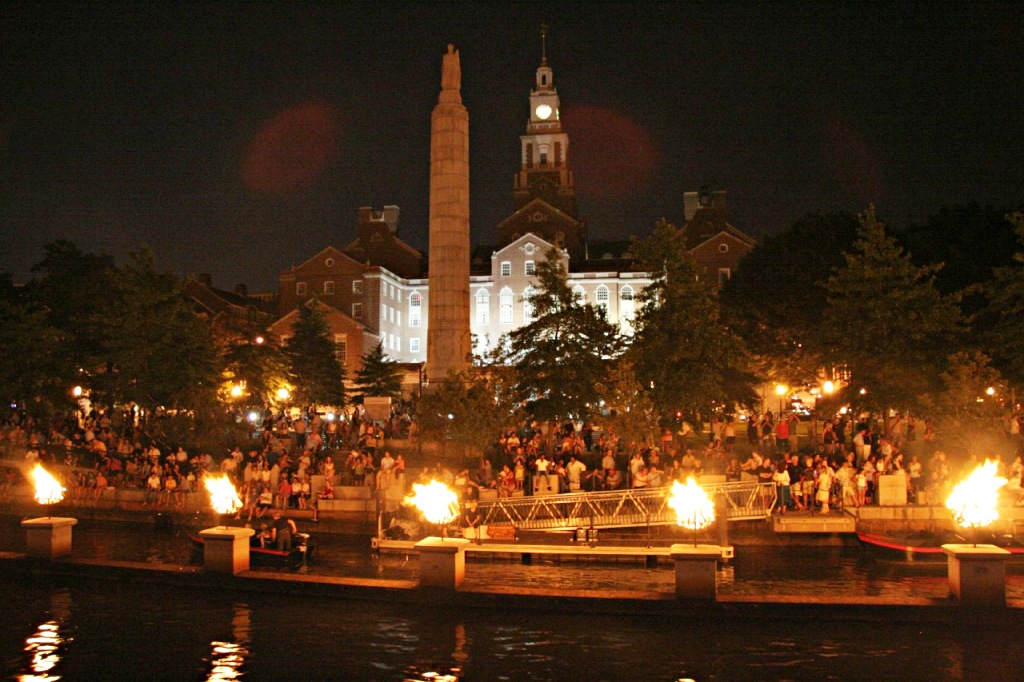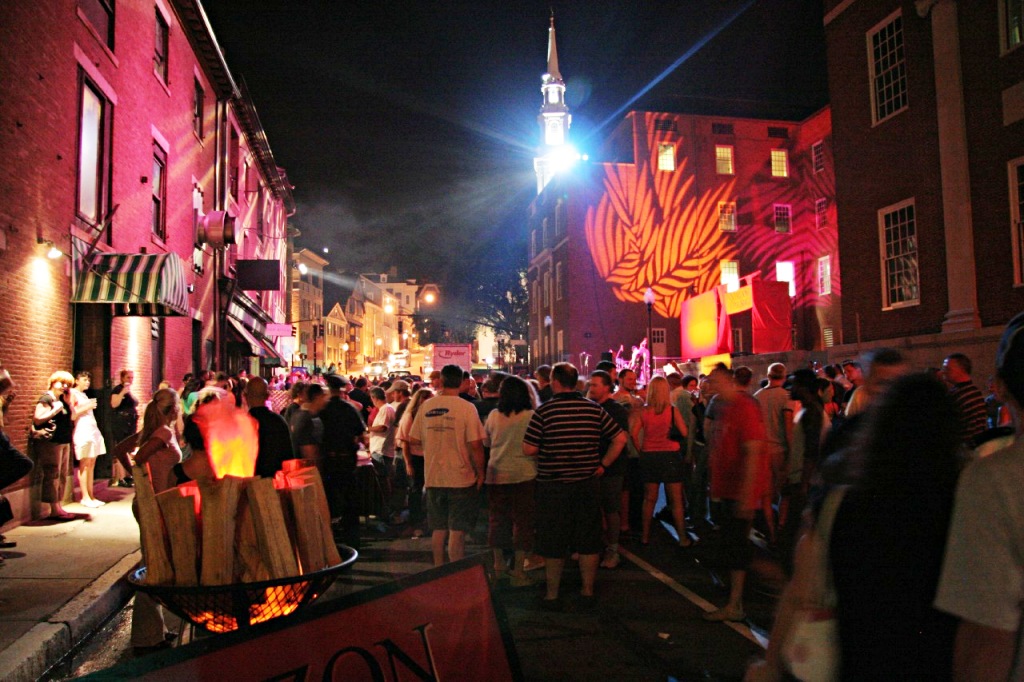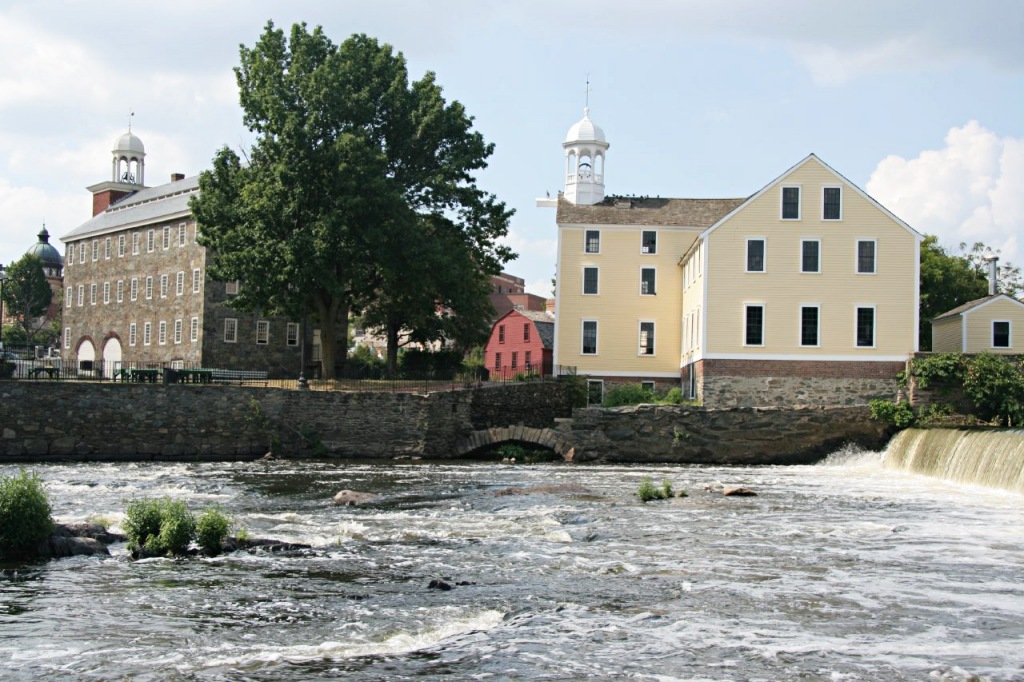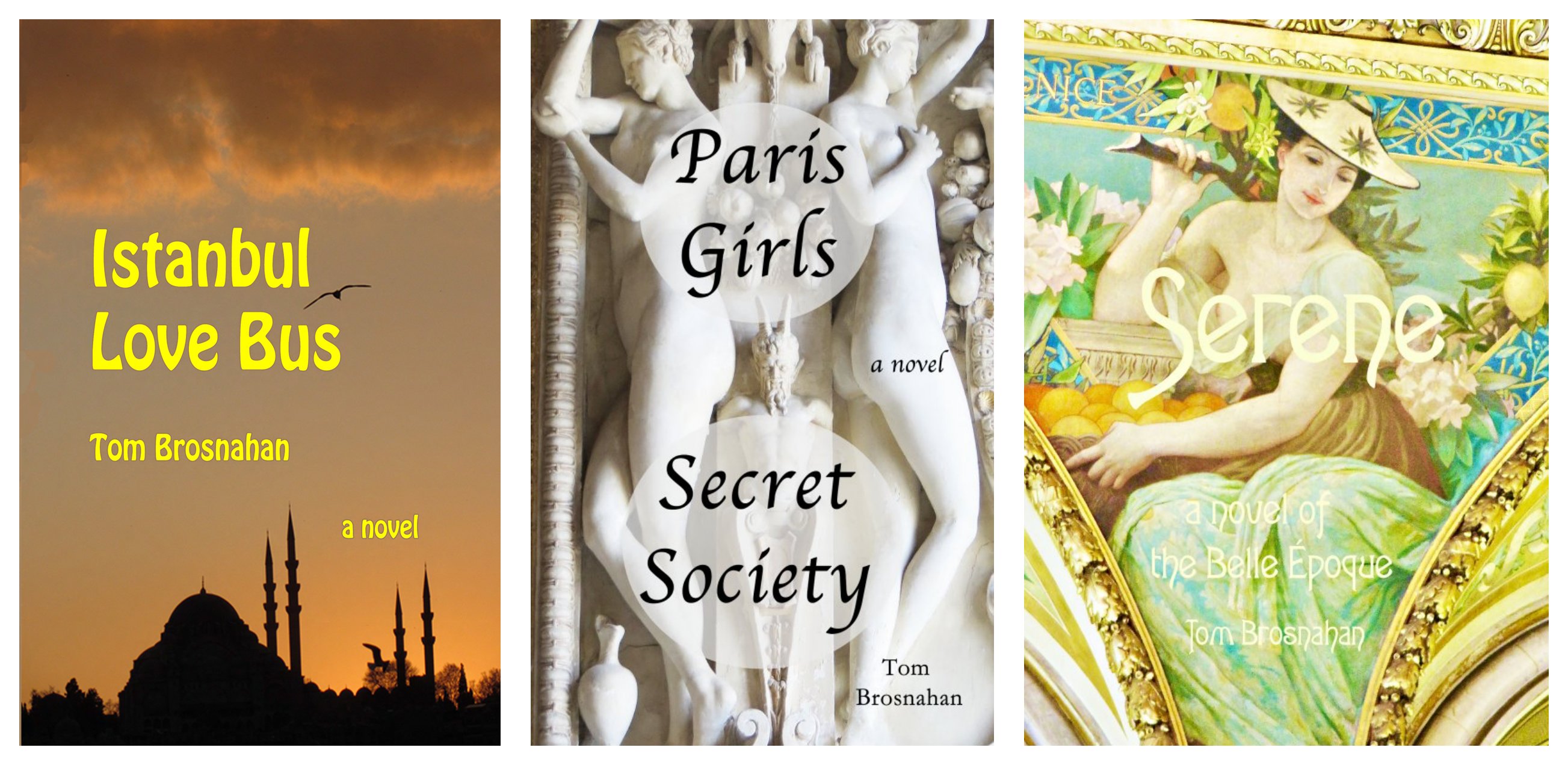Providence RI Guide
Providence is just great! Downtown (the city center) is compact: you can walk to almost everything there is to see and do. Dining is another strong point. Then there's Waterfire!
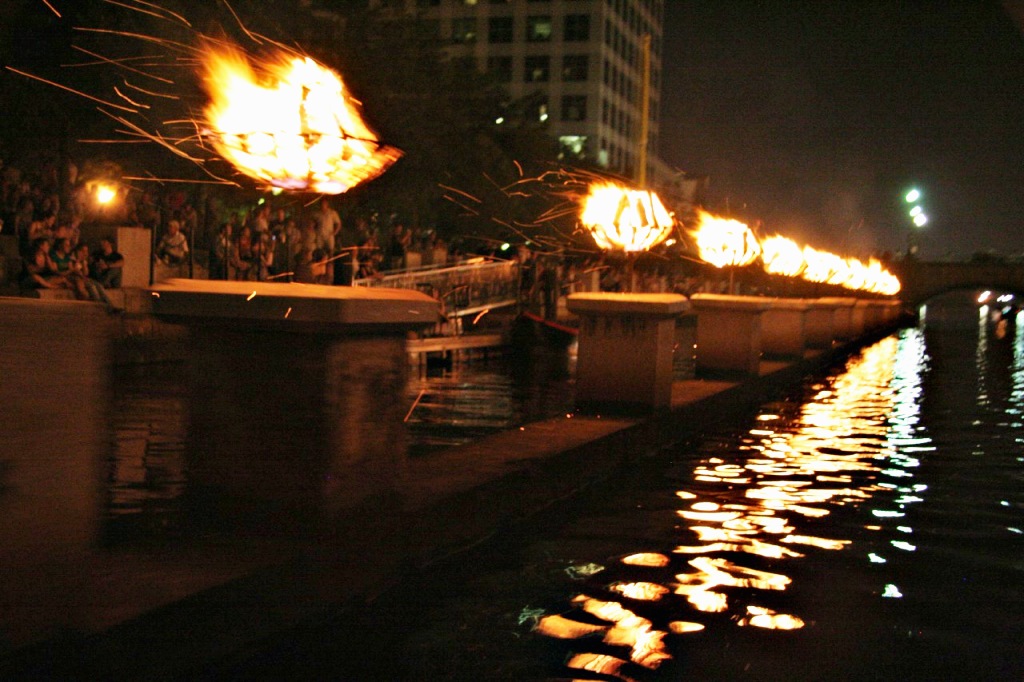
Wood fires blazing along the Providence River for Waterfire.
Founded in 1636 by Roger Williams, a religious dissenter from Massachusetts, Providence welcomed people of all religions and backgrounds. It suffered economic and civic decline from the 1950s through the 1980s, but its renaissance in the 1990s has produced a delightful place to visit or to live.
Only 51 miles (82 km) southwest of Boston and 181 miles (291 km) northeast of New York City (map), Providence attracts visitors with its manageable size, its architecture, its fine museums, universities, parks (especially its restored Providence River Waterplace Park), and the unusual civic pageant called Waterfire.
Orientation
The center of Providence is Kennedy Plaza, marked by the city hall and The Graduate Hotel (map). Kennedy Plaza is also the site of Kennedy Plaza Intermodal Transportation Center, with city, intercity and regional bus stops, including for Peter Pan Bus Lines, Flixbus, and Greyhound Lines.
The Rhode Island State House (capitol), a pleasant and harmonious building of white Georgia marble and the predominant landmark in the city center, crowns a hilltop just ten minutes' walk northwest from Kennedy Plaza. It's well worth a visit.

The Rhode Island State House in Providence...
Between Kennedy Plaza and the State House is Providence Station for Amtrak and MBTA Commuter Rail trains.
On the opposite (east) bank of the Providence River, which runs through the city center, rises College Hill, where you'll find Brown University, the Rhode Island School of Design, and a collection of exceptionally beautiful and interesting houses from the 17th, 18th, and 19th centuries.
A Bit of History
Providence was founded in 1636 by Roger Williams( 1603-83) whose freethinking religious ideas got him banished from the colony of Massachusetts Bay.
Williams had been minister of the church at Salem MA, but he believed that the Massachusetts Bay charter was not legal; that the Puritans should face the fact that they had really separated from the Church of England; and that in matters of conscience, no civil authority had any power over the individual.
No wonder the powers-that-be thought him a dangerous man!
Because of his own belief in freethinking, he dedicated his new settlement of Providence to the proposition that all people should have freedom of conscience, and of worship.
A good number of people came from Massachusetts, and others came directly from England, to the new colony.
Williams had bought the land for the town from the Narragansett Indians, and he remained on very good terms with them, even writing a book on their language which was published and sold in England.
Providence became the first colony to declare independence from England, in May 1776.
After the Revolutionary War, it took over from Newport the position as the state's most important seaport.
It's still an important port, and its industries of textiles, machine tools, rubber, jewelry, and boatbuilding also contribute to its prosperity.
What to See & Do
Walking Tour
The best way to get to know and enjoy Providence, its architectural, artistic and cultural richness, is on my two-hour downtown Walking Tour (map).
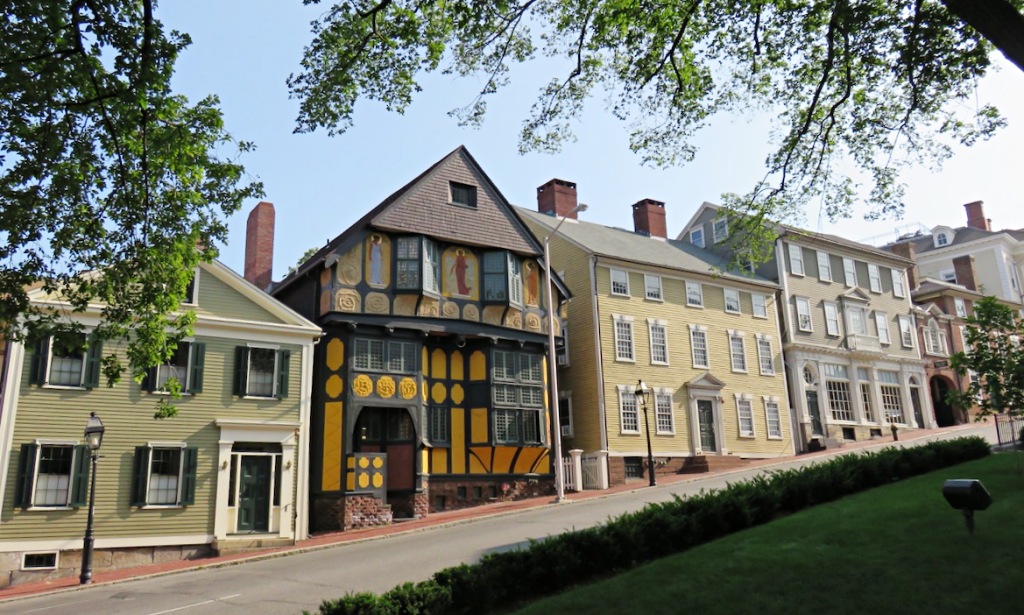
Thomas Street - "Artists' Row."
This 2-hour walk (not including stops) begins at Burnside Park, adjoining Kennedy Plaza in the center of Providence, and ends on College Hill at Prospect Terrace Park, with a fine view of the city (map).
The walk is best done on weekends when there is less traffic. Avoid walking during the morning and evening rush hours. While walking, look up frequently—Providence has a lot of interesting architecture.
Downtown Providence
1. Burnside Park & Kennedy Plaza
In the center of Providence, Burnside Park's shady trees and benches make the plaza an oasis in the middle of the city next to bustling Kennedy Plaza. An equestrian statue of General Ambrose Burnside (1824-1881) watches over the eastern end of the plaza. Three times governor of Rhode Island and a successful inventor and industrialist, he is remembered today mostly for his long, bushy side whiskers, which gave us the term "sideburns."
The plaza is also a place for unemployed people to hang out, and has its share of panhandlers (beggars).
At the western end of Kennedy Plaza is:
2. Providence City Hall
At the southwestern end of Kennedy Plaza (25 Dorrance Street), Providence's municipal headquarters is an agreeable Second Empire building completed in 1878 (go inside to see a wall display of other entries in the competition for the city hall design). More...
3. The Graduate Providence Hotel

This easily-visible Providence landmark across the street from City Hall and overlooking Kennedy Plaza, this grand old hotel boasts the city's prime lodging location. Built in 1922 as the Providence Biltmore, its marvelous Art Deco lobby and other features have been well preserved, its guest rooms renovated with today's comforts and conveniences. More...
4. The Round Top Church
Officially known as the Beneficent Congregational Meetinghouse (UCC), this classic structure got its popular name from its dome, a departure from the usual New England Christopher Wren-style church spire. Finished in 1810, the Round Top Church was influenced by the classical revival then going on in Europe.
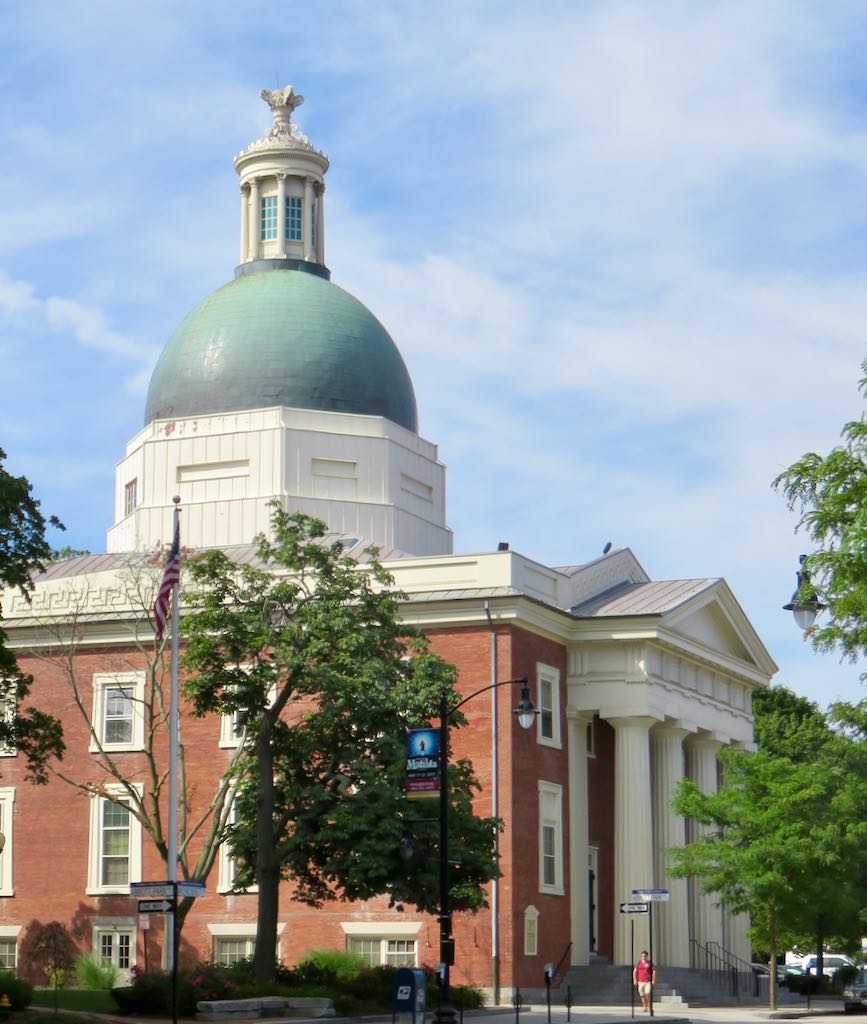
Enter the church by the door on the side, around to the right. The interior is as pleasant as the exterior: besides the gracious New England meetinghouse furnishings, the Round Top Church has a crystal chandelier consisting of almost 6,000 pieces.
5. The Arcade
At 130 Westminster Street (map), looks like an imaginative bit of urban renewal, but is in fact the creation of Russell Warren and James Bucklin, who designed the building in 1827. Taking their cue from the covered passages of Paris, they built a walk-through marketplace of shops topped by a glass roof.
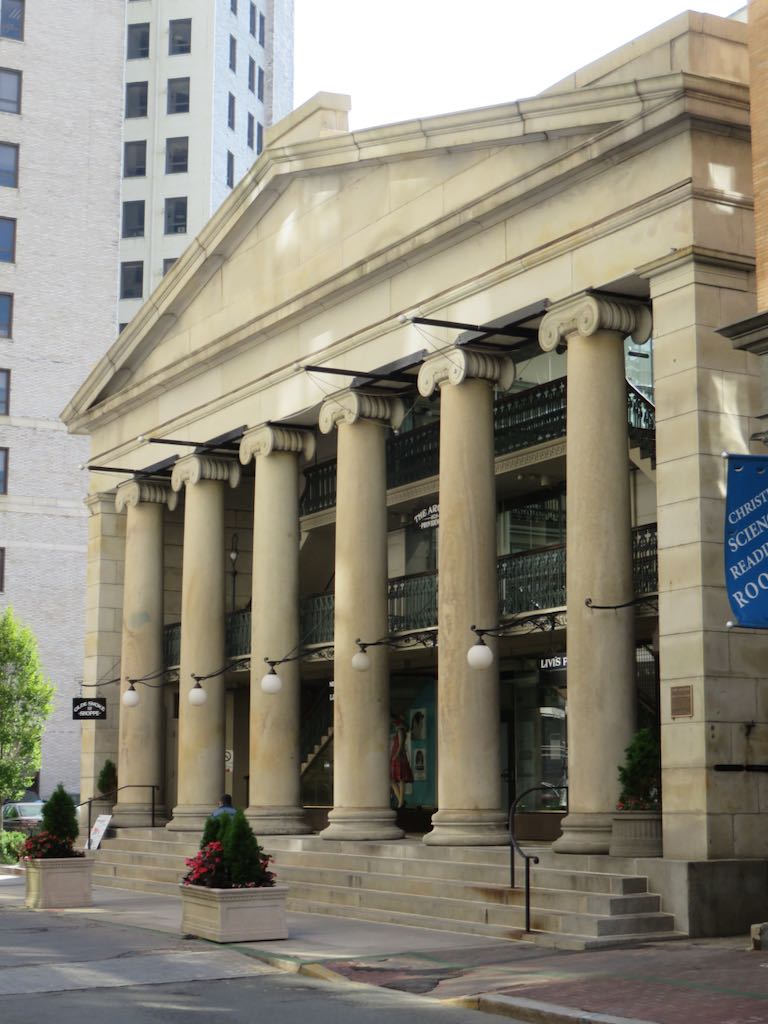
The classical façades (look at both facades, on Westminster Street and on Weybosset Street, each done by one of the architects), the decorative cast-iron stairways and balustrades, the three three levels of shop) made such passages the first "shopping malls." Shoppers could visit several shops in one trip without long walks in between, and be protected from the weather. The passage between two busy city-center streets increased foot traffic, and thus the value of the location for shopkeepers.
Today The Arcade still has a number of shops and a café on the ground floor, but the upper floors have been converted to condominium residences.
Rhode Island State House
6. Rhode Island State House
Rhode Island's state capitol, boasting one of the world's largest self-supporting domes, rises above the city center on its hill to the north.
Rhode Island government was conducted in the Old State House (1762), on North Main Street between North and South Court streets, from 1762 to 1895, when the cornerstone of the new Rhode Island State House was laid at 82 Smith Street.
Modeled by McKim, Mead and White on the dome of St. Peter's basilica at the Vatican, the State House dome is the world's fourth-largest unsupported dome (St. Peter's is first.)
Whether it is "the most beautiful state capitol in the country," as the state's tourist brochures claim, might be disputed by admirers of 49 other such capitols, but certainly it is one of the more beautiful.
Atop the dome stands a gilded statue of Independent Man, symbolizing freedom and free will. Placed here in 1899, it's been removed twice for re-gilding and renovation of its marble base, in 1976 and December 2023.
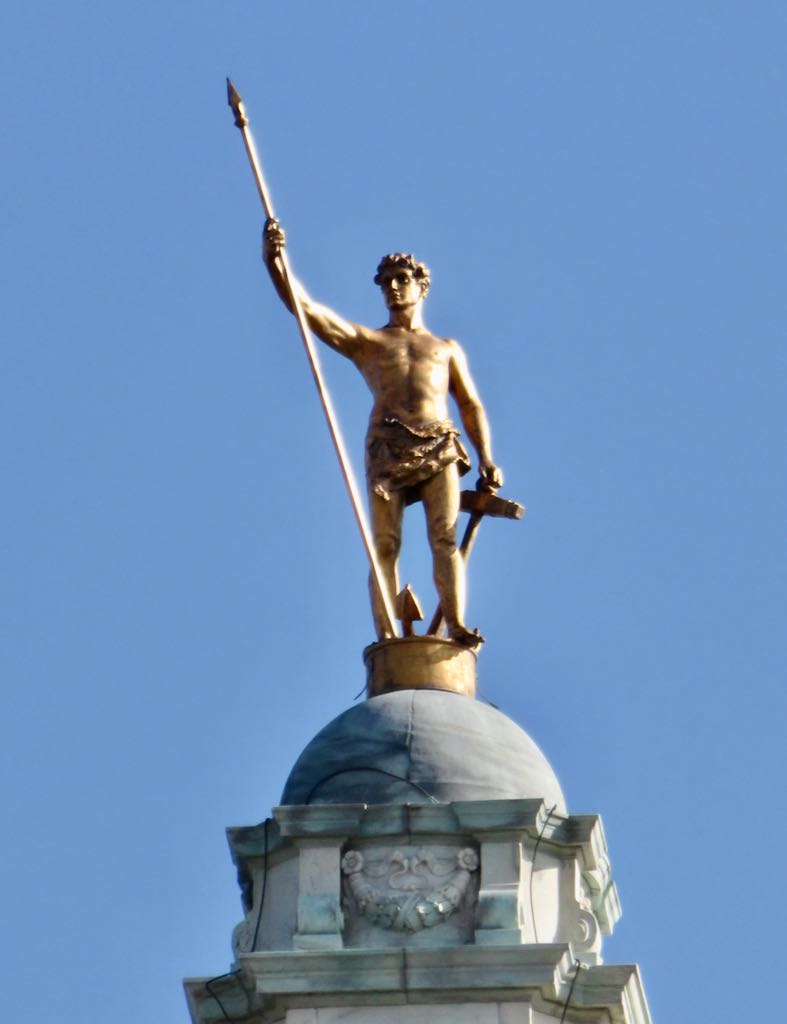
Enter by the portal on Smith Street (US Route 44; map) to see display cases filled with battle flags from the state's proud military units which served in the Civil War, the Spanish-American War, and the World Wars.
The Tale of the Gettsyburg Gun
Among the military displays is The Gettysburg Gun, a Civil War cannon that was hit right in the muzzle by another cannon's ball. When the crew tried to charge the cannon again, they put the powder and wad in but couldn't get the ball in. Then they couldn't get the ball out. The gun was retired, but it was only in the 1960s, after the cannon had been in the State House for decades, that someone remembered the gunpowder charge! So after 100 years of being loaded and ready to blow a hole in the wall of the State House, the Civil War cannon was finally de-charged.

Beyond the cannon is the rich, gleaming marble interior and hallways decorated with paintings of the founding fathers of Rhode Island and Providence Plantations the state's official name (until 2020, when Rhode Islanders voted to drop "Providence Plantations" from the name granted in 1663.)
Inside is the Rhode Island Charter Museum, featuring the Royal Charter (1663) for "Rhode Island and Providence Plantations," other historical documents and artifacts; the State Room with Gilbert Stuart's famous portrait of George Washington; and the Rotunda beneath that huge marble dome.
Visit the State House on any weekday (but not holidays). Allow time for the securyt check. Tour on your own with a guide pamphlet, or take a free guided tour. More...
7. Providence Place Mall
As you walk toward the state house along the grassy mall north of Waterplace Park and the Providence Train Station (map), to the left (west) along Francis Street is Providence Place, the large urban shopping mall that was a key feature in Providence's commercial renaissance.
College Hill
8. College Hill
Cross the Providence River on College Street to College Hill (map), the prettiest and most historic section of the city. Its streets are lined with 18th- and 19th-century houses, most of which have been well preserved or restored and many of which bear plaques, put up by the Providence Preservation Society, giving the builder's name and the date of construction.
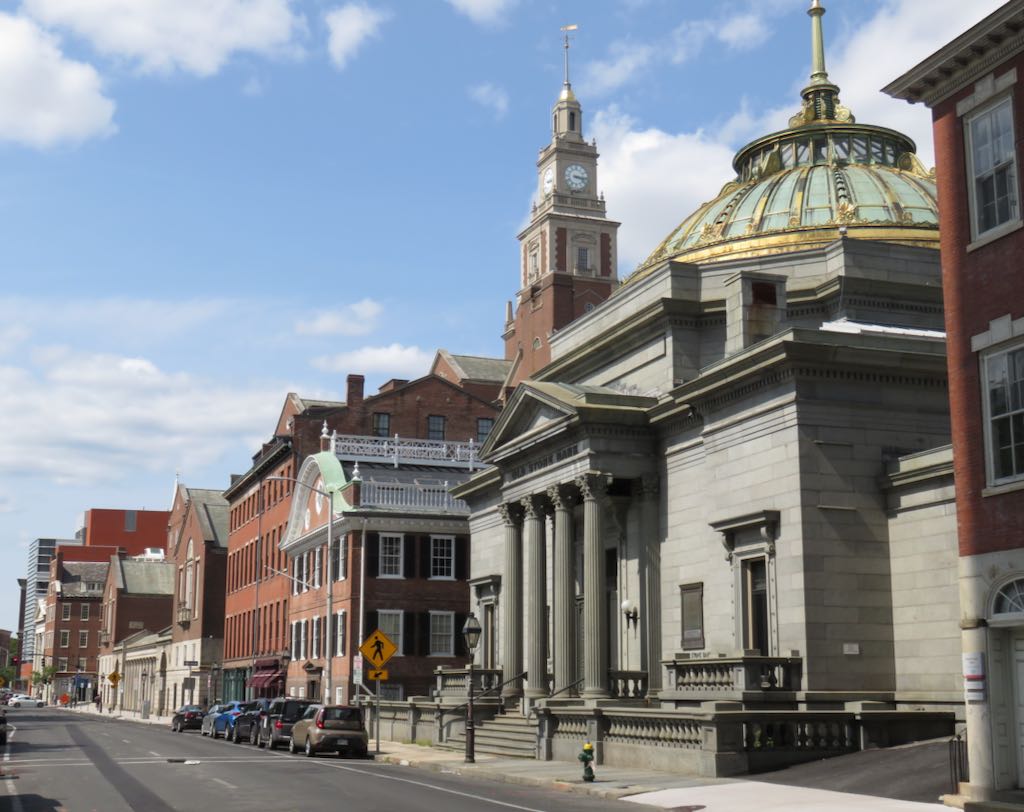
Main Street, at the base of College Hill.
9. Brown University
The seventh-oldest university in the USA (1764), Brown University is a member of the Ivy League. Its campus and buildings spread over the slopes of College Hill. University Hall was used as a barracks for colonial and French soldiers during the American Revolution. To get to it, walk up the hill (east) on Waterman Street, cross Prospect Street, and turn into the gates on your right. Free campus tours are available. More...
10. John Brown House Museum
Proclaimed by John Quincy Adams to be "the most magnificent and elegant private mansion that I have seen on this continent," this restored house-museum at 52 Power Street, corner of Benefit Street was built in 1786. It reveals the prosperity of post-Revolutionary Providence and houses an outstanding collection of furnishings and decorative arts.
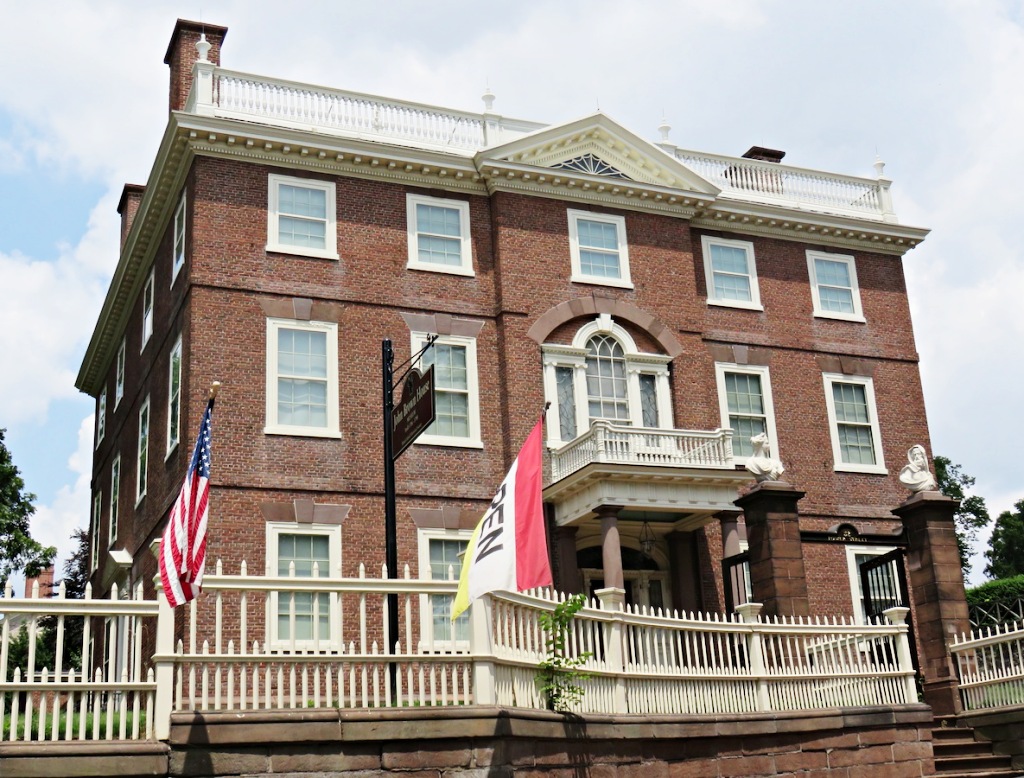
John Brown House, now a museum.
John Brown (1736-1803) was a farmer, shipowner, merchant, slave-trader, privateer and statesman whose ships plied the seas both east and west out of Narragansett Bay and ultimately made him a wealthy man.
In 1764, John Brown, along with his brothers Moses and Nicholas, and several Providence clergymen, established "the College in the English Colony of Rhode Island and Providence Plantations" which was later renamed Brown University.
In 1775, Brown rechristened his ship Katy to be the Providence and sold it to the revolutionary Continental American government—the first ship in what would become the United States Navy.
The Brown family had been prominent in Providence commerce and industry since the early 1700s. John's brother, Moses, joined with Samuel Slater to set up the first water-powered cotton spinning mill in America in 1790, now known as Slater Mill.
In 1794, the United States Congress passed a law against the slave trade. In 1797 Brown was the first slave-trader to be prosecuted under the law. He lost, and forfeited one of his ships.
From 1799 to 1801, John Brown served as a congressman in the US House of Representatives.
Today the John Brown House, maintained by the Rhode Island Historical Society, is a repository for documents, artifacts and artworks relating to Rhode Island history, society and culture.
11. The Rhode Island School of Design
RISD, (known in Providence as "RIZZ-dee") is one of the country's best art, architecture, and design schools. Founded in 1877, it boasts the excellent RISD Museum of Art.
RISD Museum of Art
The Museum of Art of the Rhode Island School of Design at 224 Benefit Street (map) is one of the best small art museums in New England, with more than 100,000 works of art from Europe, the Americas, ancient Greece and Rome, China and Japan, including paintings by European masters as well as American painting, furniture, costumes, and modern works of art. Rodin's Balzac is here, as is Monet's Bassin d'Argenteuil.
European, American and Latin American artists include George Wesley Bellows, Georges Braque, Mary Cassatt, Paul Cézanne, William Merritt Chase, Thomas Cole, John Singleton Copley, Edgar Degas, Roberto Matta Echuarren, Hendrick Goltzius, Martin Johnson Heade, Robert Henri, Winslow Homer, Angelica Kauffmann, Oskar Kokoschka, Wifredo Lam, Fernand Léger, Edouard Manet, Henri Matisse, Claude Monet, Lippo Memmi, Georgia O’Keeffe, Maxfield Parrish, Nicolas Poussin, Pablo Picasso, Nancy Elizabeth Prophet, Joshua Reynolds, Tilman Riemenschneider, Auguste Rodin, Salomon van Ruysdael, John Singer Sargent, Charles Sheeler, Gilbert Stuart, Giovanni Battista Tiepolo, Joaquín Torres-Garcia, and others.
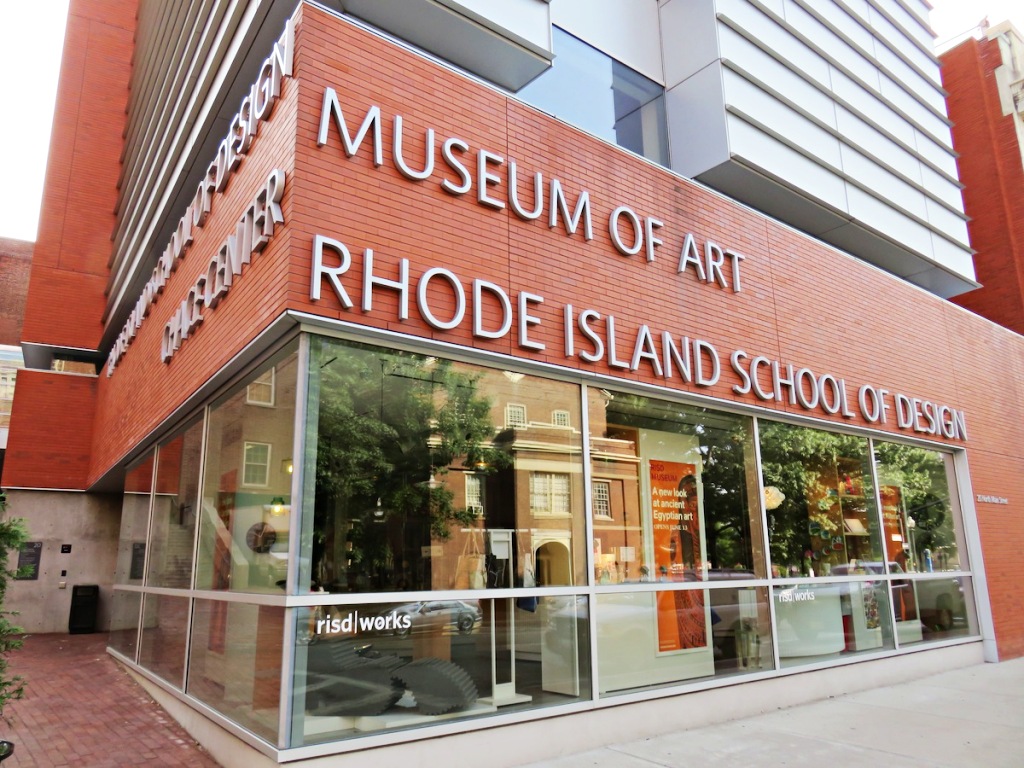
North Main Street Entrance, RISD Museum...
For current exhibits, see the RISD Museum website.
At the bottom of College Hill, on South Main Street between Thomas and Waterman streets, take a stroll past the:
12. First Baptist Church in America
Roger Williams founded the first Baptist congregation in the New World in 1638, but this building dates from 1775. The architect was Joseph Brown, and the steeple—designed from a plate in James Gibbs's Book of Architecture representing suggested steeples for St Martin-in-the-Fields in London—rises to a height of 185 feet (56 meters).
Between November and March the church is open daily, but guides are available only by appointment. The front door of the church will probably be locked, so go around to the right to the side (office) door.
13. Fleur-de-Lys Studios
To the north of the First Baptist Church at 7 Thomas Street is a fantastic old building with half-timbering and stucco bas-reliefs on its façade.
Built by Providence artist Sidney Burleigh in 1885 (the date is in the stucco), it's a feature of Thomas Street's "Artists' Row," which includes the Providence Art Club, at no. 11. The club has changing shows exhibited in its galleries.
14. Prospect Terrace Park
From the Fleur-de-Lys Studios go to Cushing Street and turn left. From the Terrace, a small park, you can see downtown Providence and the State House, along with a famous but—pardon me—rather wooden statue of the founder, Roger Williams. His grave is here as well.
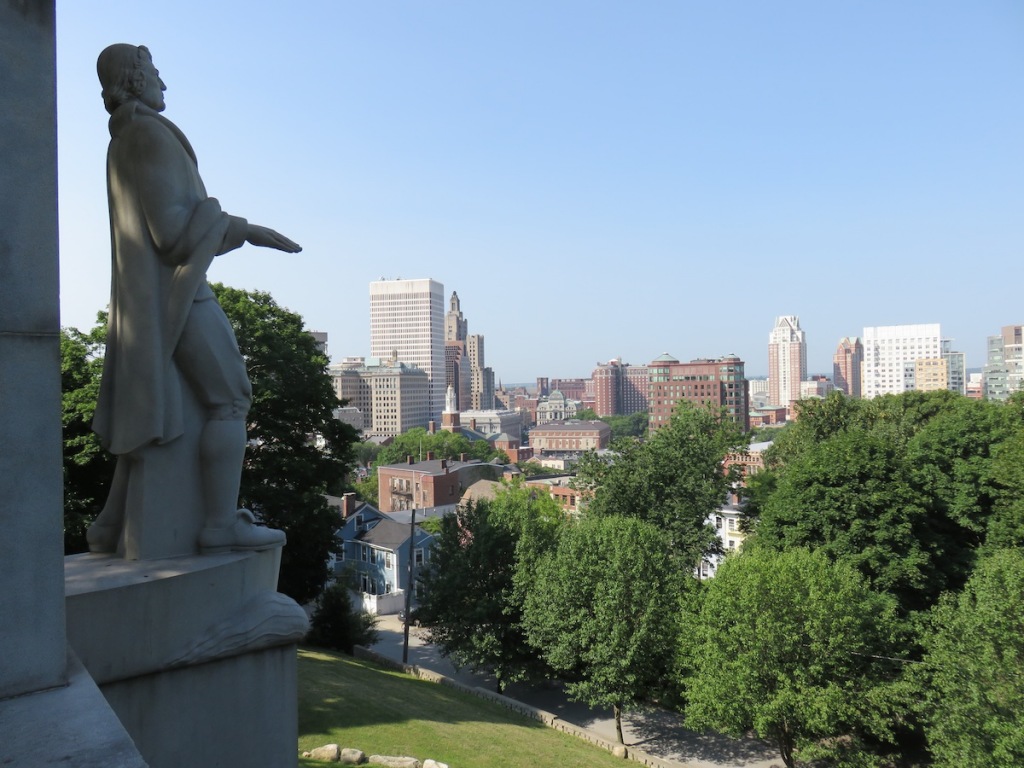
Roger Williams blessing his city.
Trees have grown up below and block a bit of the perspective, but the view is still panoramic and impressive.
15. Providence Preservation Society
The Providence Preservation Society, 21 Meeting Street, has additional information on historic preservation in Providence.
Waterplace Park
16.Waterplace Park & River Walk
This 4-acre (1.6-hectare) park along the Providence River (map) frames the river and a tidal basinthrough the heart of the city. Good for wandering and relaxing anytime, it's particularly pleasant in the evening, and especially exciting when there are festivals, concerts and events, prime among which is Waterfire.
Waterplace Park & the Providence River.
17. Waterfire
Waterfire, the brainchild of Providence RI installation artist Barnaby Evans, is a hundred blazing-log-filled braziers floating in the river right in the city center as dozens of huge loudspeakers play music to accompany the spectacle.
People throng the riverbanks to watch the blaze, the showers of sparks, the boats and gondolas cruising the river right by the blazes, and to listen to the music which ranges from classical to pop to rock to exotic foreign tunes.
Performance artists set up on street corners, in parks and on bridges to amuse the crowds. Snack stands set up shop on streets closed to traffic. Restaurants along the riverbanks fill to capacity as diners watch all the action right from their tables.
The performance artist named Spark plays with fire.
Most people think of waterfire as the blazing fires in the river, but the art installation, fascinating as it is, is really just a wonderful, captivating excuse for a gigantic street party.
Waterfire is a nonprofit artistic and social event supported by corporate and private sponsors and volunteers. The event takes place on designated nights throughout the year, beginning at sunset and lasting until 1 am. It is open to the public at no charge.
Hundreds of volunteers help to run it, floating and anchoring the buoyed braziers in the river, loading them with firewood, lighting and refueling them from boats during the evening, and performing all the many tasks to keep such a mammoth undertaking running smoothly.
Providence is packed on Waterfire nights, its hotels heavily booked, its parking spaces filled well before sunset. Make plans and hotel reservations, and arrive early if you want your choice of these services.
Come to see the fires in the river but, more than that, come to enjoy the festival atmosphere, to people-watch, to see and be seen, to observe the street performers, to be part of something big and beautiful, to get in the spirit of yet one more thing that makes Providence such a wonderful city.
For more information and dates of the Waterfire events, see the Waterfire website.
Roger Williams Park & Zoo
Hundreds of acres of beautifully kept lawns, copses, lakes, and paths, plenty of amusements and play areas for children, an old-fashioned summer "casino," a Natural History Museum: this oasis a few minutes' drive south of Providence is the place to get away from the city and the highway.
Roger Williams Park: wildlife galore!
Four miles (6.5 km) south of the city on Elmwood Avenue (I-95, Exit 17; map), Roger Williams Park boasts magnificent restored 19th-century Victorian buildings, the Charles E Smith Greenhouses, a Museum of Natural History, the Roger Williams Park Zoo, and plenty of amusements and play areas for children, an old-fashioped summer "casino," besides its 430 acres of beautifully kept lawns, copses, lakes, and paths.
The park is open to the public for free, and special concerts and programs are scheduled throughout the summer.
In summer, kids paddle in goose-shaped boats along its lakes and streams while other kids enjoy the classic carousel (Merry-go-round) right next to a toddlers' playground and a bigger kids' rock-climbing tower, while parents relax on a picnic blanket with a book, a radio, or the newspaper.
The Roger Williams Park Zoo harbors nearly a thousand animals, and is a favorite for both kids and adults.
If you need a morning, afternoon or all-day getaway from the city or the highway, this is the place.
Old Slater Mill
Water-powered cotton and textile mills built from plans stolen from England changed all of New England in the 19th century. It all started in Pawtucket, 5 miles (8 km) north of downtown Providence (map). The mills (1793-1810) here have many of their old machines in working order.
In 1793 three enterprising men named Slater, Almy, and Brown set up the first water-powered cotton-spinning factory in America, on the Blackstone River. Today the early mills and the Sylvanus Brown House (1758), home of the skilled artisan, make up the Old Slater Mill National Historic Landmark.
The mills have many of their old machines in working order, such as the water wheel, shafts, and pulleys in Wilkinson Mill (1810), and you can see them in action. Earlier handcraft devices for doing the same jobs are also on display to show you what a breakthrough the machine-filled Slater Mill (1793) was.
The Old Slater Mill is now part of the Blackstone River Valley National Historical Park
Besides the permanent exhibits, traveling and temporary displays are set up from time to time, and guided tours interpret the history of the textile industry and the impact of factories on working conditions.
To get there by car, take I-95 north from Providence, get off at Exit 28, and turn left (under the highway) onto School Street. Cross the Blackstone River and turn right onto Roosevelt Avenue; the Slater Mill Historic Site is on your right.
From Boston or the north, follow I-95 south to Exit 27 and follow signs to the mill.
Where to Stay
Besides the several large hotels and varied inns and bed-and-breakfast guesthouses in Providence itself, there are numerous hotels and motels in the neighboring cities of Warwick RI, Pawtucket RI, and Seekonk MA.
Use this handy Hotel Map with Prices to find the hotel you want in Providence.
Where to Dine
Providence is definitely a good dining town, with dozens of great restaurants. Because Providence is the home of Johnson & Wales University, one of America's foremost institutions of higher education teaching the culinary arts and the business of hospitality, the city always has a good supply of eager and talented chefs. The dining scene is great!
Downtown Providence Restaurants
Hemenway's Seafood Grill & Oyster Bar
By the southern end of Providence Memorial Park overlooking the river and just across from The Old Stone Bank, Hemenway's is Providence's favorite seafood restaurant. Tall ceilings, huge windows, outdoor terrace seating, views of the city and the river, and dependably fresh seafood prepared in innovative ways is the draw here. More...
Federal Hill Restaurants
The Italian neighborhood of Federal Hill centered on Atwells Avenue is lined with small bistro-type restaurants serving Italian, Lebanese, Mexican, Thai and other cuisines—but the predominance is Italian.
Also here are several delicatessens, bakeries, gourmet shops and other food-related shops.
If you enjoy eating (who doesn't?), take a stroll over to Federal Hill, or ride RIPTA Bus 92 from Kennedy Plaza to Atwells Avenue. You'll know you've arrived after you pass beneath the huge La Pigna (Pine Cone) gateway arch across Atwells Avenue. The pine cond is a traditional Italian symbol of welcome, goodness and...pine nuts!
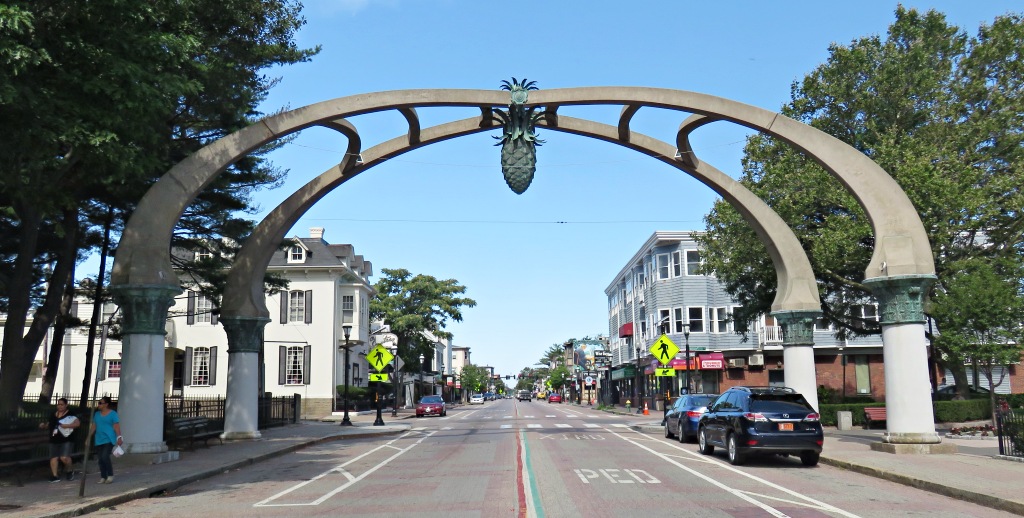
La Pigna Gateway Arch: it's a pine cone, not a pineapple...
Transportation
Providence RI and Boston MA are about one hour apart by car or train, and Providence is an important transit point for bus and train passengers to Newport RI and Cape Cod MA.
Amtrak trains link Providence to New York City, the Connecticut Shoreline, and Boston. MBTA Commuter Rail trains take you between Providence and Boston in only one hour. Peter Pan and Greyhound intercity buses make these connections, and go to Cape Cod and other New England destinations as well.
T F Green Airport, just south of Providence in Warwick RI, serves not only Rhode Island, but also eastern Massachusetts and southeastern Connecticut.
Car
Interstate 95 goes right through the center of Providence on its way between New York City and Boston (map). In the center of Providence, I-195 branches off to go through Fall River MA (the turnoff for Newport RI), New Bedford MA, and then on to Cape Cod.
Distances from Providence
—Boston MA: 45 miles (73 km) NE, 1 hour
—Hyannis MA (Cape Cod): 76 miles (122 km) E, 1.5 hours
—Newport RI: 30 miles (48 km) S, 50 minutes
—New Bedford MA: 32 miles (51.5 km) SE, 45 minutes
—New London CT: 55 miles (89 km) SW, 1.25 hours
—New York City: 182 miles (293 km) SW, 3.5 hours
—Plymouth MA: 54 miles (87 km) E, 1 hour
Parking in Providence
Street parking in Providence is scarce, and meters are checked frequently. The center of town has lots of private pay lots, which it is best to use if you need to be downtown.
Otherwise, park on a side street on College Hill, where there's plenty of shade. In summer there are usually plenty of places, but they fill up when the colleges (Brown University and the Rhode Island School of Design) are in session from mid-September through May.
Train
More than a dozen Amtrak trains a day from New York City (3 to 4 hours) and from Boston MA (1 hour) arrive at Providence Train Station just down the hill from the State House on the way to Waterplace Park and Kennedy Plaza (map). More...
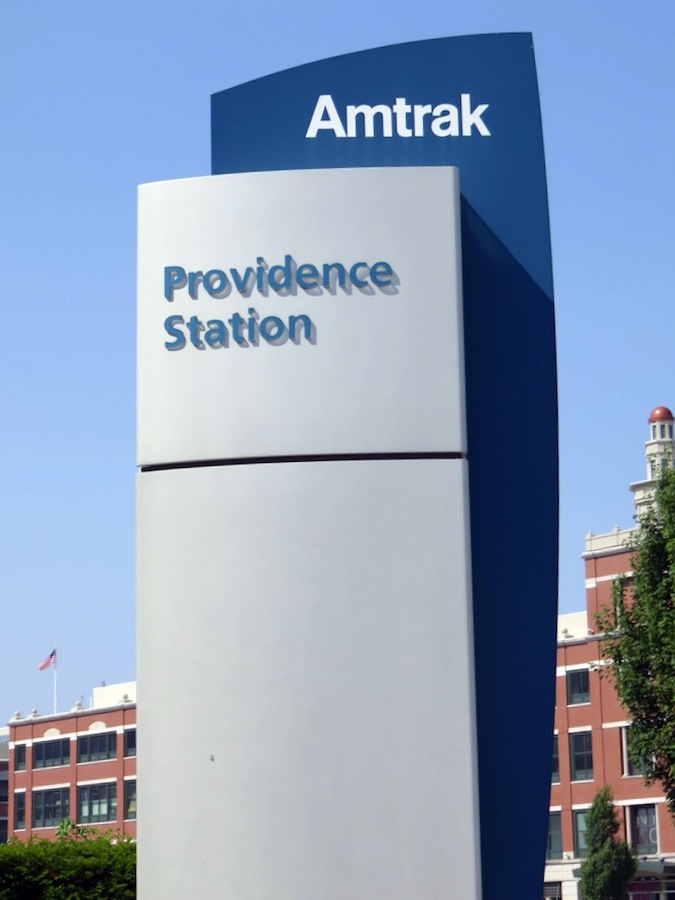
In addition, MBTA Commuter Rail runs 20 trains each weekday (9 on Saturday, 7 on Sunday) on its Providence-Stoughton Line between Providence Station and Boston's South Station (1 hour). Weekday trains run all the way to Providence's T F Green Airport (1.25 hours) and beyond to the Wickford Junction InterLink Transit Center in North Kingstown. More...
Bus
Altogether, Peter Pan Bus, Flixbus and Greyhound runs eight buses daily to Providence from New York City, Boston MA, Newport RI, Hartford CT, Hyannis (Cape Cod) MA, Springfield MA, and Albany NY. Travel time from New York City is about 4 hours; from Boston or Newport about 1 hour, from Hyannis (Cape Cod) MA about 1.5 to 2 hours.
The main Peter Pan Bus Terminal serving Peter Pan, Flixbus and Greyhound buses is 2.3 miles (3.7 km) north of the center (I-95, Exit 25A; map). Some of these buses also stop at Providence's Kennedy Plaza Intermodal Transportation Center.
Here is a plan of the Kennedy Intermodal Transportation Center.
Plane
Rhode Island is so compact that one airport handles all the important national flights: it's T F Green State Airport (PVD) i, 2000 Post Road (US Route 1) in Warwick, RI, 10 miles (16 km) south of Providence (map).
T F Green International Airport (PVD)
Theodore Francis Green Memorial State Airport (PVD) in Warwick RI south of Providence at I-95 Exit 13 (map) has become more important as a regional hub supplementing Boston's Logan International Airport.
T F Green Airport hosts several low-fare airlines such as Southwest. Many residents of eastern Massachusetts travel to Green Airport just for the low fares and low parking fees.
MBTA Commuter Rail trains on the Providence/ Stoughton Line connect Green Airport's InterLink facility with the city centers of Providence and Boston. The InterLink also holds all car rental operations at the airport, as well as parking for commuters and travelers.
Besides Commuter Rail trains, taxis, rental cars and a few shuttle services take passengers to and from the airport.
Providence - Bristol - Newport Ferry
Seastreak ferries operates fast catamaran passenger ferryboats between the Providence Ferry Terminal, 25 India Street, Providence (map), Bristol RI, and the Newport Ferry Terminal at 39 America's Cup Avenue, Newport: three departures daily from each city Monday through Thursday, and four departures Friday through Sunday.
The voyage down the Providence River takes one hour.
There's complimentary shuttle bus service connecting the Providence train station, convention center, downtown, and the Providence Ferry Terminal. On the air-conditioned boat there's free Wifi and a bar serving wine, beer, cocktails, soft drinks and snacks. An open-air top deck allows you to take in the sun and the views. More...

